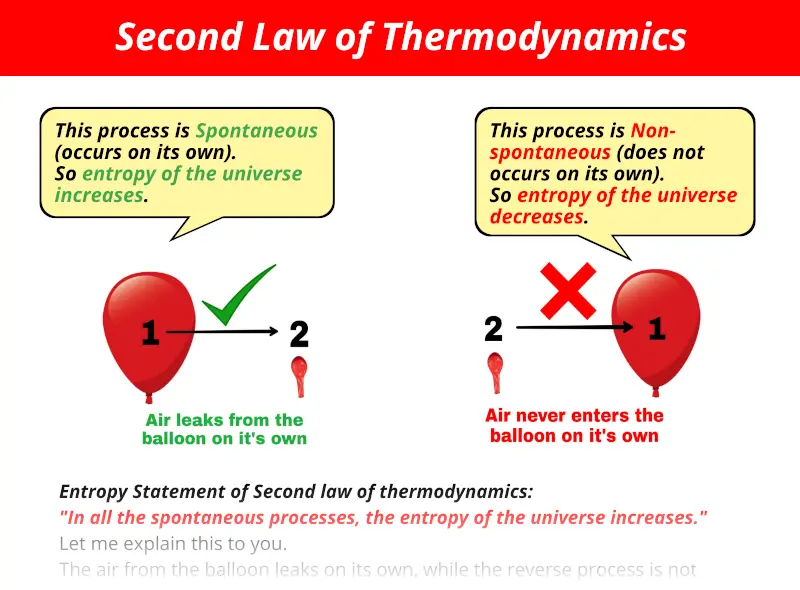
The air leaks from the balloon on it’s own.
Have you noticed this on your birthday?
But have you seen the balloon getting automatically filled up with air without doing anything?
Obviously No.
Well, I know that the second law of thermodynamics is very confusing for you as it has many complex terms in it.
You might be facing problems with the statement as well as examples or something else.
But do not worry at all. I am here to help you out. (I’ll also show you the trick to remember the statement)
Also there are many ways to state this law.
Majority of students get confused because this second law of thermodynamics comes under physics subject as well as chemistry subject.
Don’t worry, you are at the right place. All of your doubts regarding the second law of thermodynamics will be solved here.
Let’s proceed with two more examples.
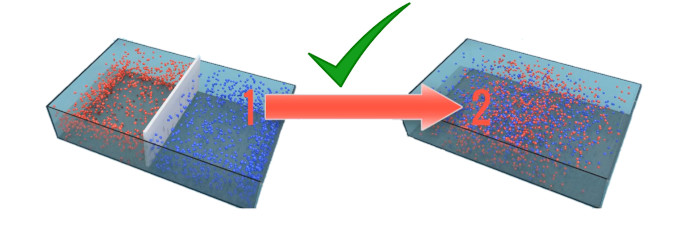
If I remove this white separator, then both the gases will get mixed with each other on it’s own.
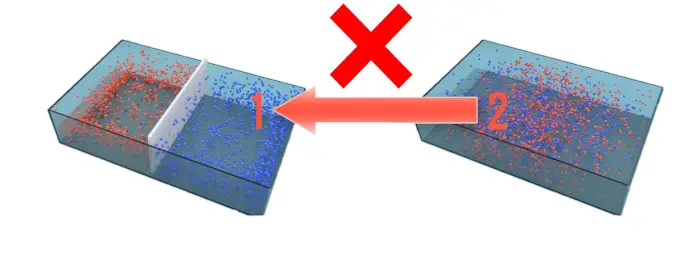
But what about the reverse process? It is possible to separate both the gases by putting the separator?
No, it is not possible.

The hot coffee will lose its heat on its own without any external help.
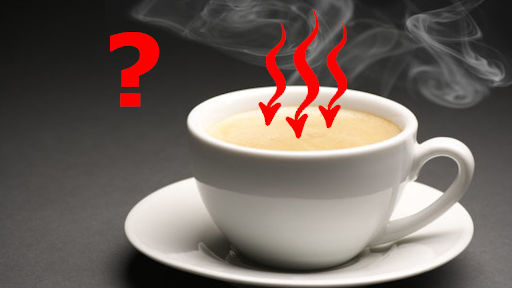
But what about the reverse process? Will this coffee absorb heat on its own?
No, it won’t.
Well, Second law of thermodynamics is all about this only. Second law of thermodynamics decides whether the process occurs on it’s own or not?
Well you might be thinking that it’s very easy, I can decide the direction of above processes without using any law (hahaha).
Yes, you can!! I completely agree with you.
But in some processes, it becomes very difficult to decide the direction in which the process will occur (for example chemical reaction).
For that, the 2nd law of thermodynamics comes into play.
There are various statements/definitions of second law of thermodynamics based on heat engine, heat pump as well as entropy.
But don’t worry, I’ll discuss all these statements here in this article.
If you want to skip to your interested topic, then feel free to check that out from the table below.
Contents
Most important question. Why do we use the 2nd law of thermodynamics?

- You have seen that air leaks from the balloon.
- Two gas will get mixed up if they are allowed to mix in the same container.
- Heat flow taking place from higher temperature body to lower temperature body.
- Hot coffee becomes cold on it’s own.
All these processes take place on it’s own and they also occur in a particular direction.
Now the statement/definition of second law of thermodynamics tells us the direction in which the process will occur.
Wait, let me explain to you with an example of a hot coffee cup.

If we keep the hot cup of coffee in the room, then it will cool down after few minutes. (That means heat will transfer from higher temperature body to lower temperature body.)
And this process occurs on it’s own.
But what about the reverse process?
Will the reverse process occur on it’s own?
Will the heat of the room be transferred back to the cup of coffee?
Well, the statement of first law of thermodynamics says that this process is possible.
Energy can be transferred from one form to another.
According to the first law of thermodynamics, the heat energy of the room can be transferred back to the coffee. But in actual practice it is not possible to have such a process taking place on it’s own.
You know that, right?
This is only the limitation of first law of thermodynamics, that it does not describe the direction of the process. In our example of coffee cup, the first law fails to say whether the spontaneous heat transfer takes place from coffee to the room or from room to the coffee?
In order to overcome this limitation of 1st law of thermodynamics, the second law of thermodynamics was discovered.
Thus,
- Second law of thermodynamics is used to check whether the process is spontaneous or not. (Whether the process occurs on its own or not?)
- It also tells us the direction in which the process will proceed.
(Guys, if you don’t know anything about the 1st law, then kindly check this article on First law of thermodynamics. You will have exact idea along with amazing examples).
What is Second law of thermodynamics?
Trust me it is very simple.
The second law of thermodynamics can be stated in three ways.
- Second law of thermodynamics for heat engine (Kelvin Planck’s statement)
- Second law of thermodynamics for heat pump/refrigerator (Clausius’s statement)
- Second law of thermodynamics based on entropy
You might have confusion regarding “What is second law of thermodynamics in physics?” and “What is second law of thermodynamics in chemistry?”
Don’t worry, this confusion will be cleared in a few seconds.
(If you have no idea about heat engine or heat pump, then kindly check the basics of thermodynamics before moving ahead, because these topics will help you perfectly understand the second law)
Second law of thermodynamics for heat engine (Kelvin Planck’s statement)
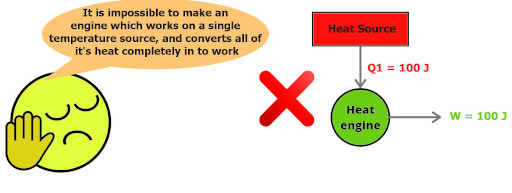
This picture will make you understand Kelvin Planck’s statement very easily. Don’t worry, I’m here to give you a clear understanding of Kelvin Planck’s statement.
Kelvin Planck’s statement:
“It is impossible to construct a device (operating in a cycle) which works on a single heat source and converts all of its heat completely in to work”
I know it’s difficult to understand this statement.
Keep reading, I’ll give you a simple explanation and also a trick to remember this.
This Kelvin Planck’s statement simply wants to say that – “A heat engine must exchange the heat with at least two thermal reservoirs, one at higher temperature and other at lower temperature, then only the engine will operate.”
Or
“Perfect engine with 100% efficiency is impossible”
Let me clarify this with an example.
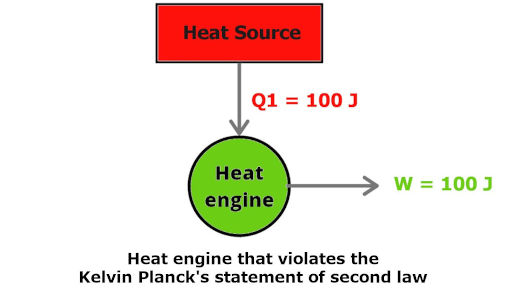
This figure shows that the engine is continuously taking heat from the heat source and converting this heat into equal amount of work.
This phenomenon is valid according to the first law of thermodynamics. First law says that one energy can be converted to another.
Yes, and here that exact process is occurring in this above picture. So according to the first law of thermodynamics, this process is possible.
But this heat engine is not having any lower temperature reservoir to absorb the heat. So according to the second law of thermodynamics, this type of heat engine is not possible, which works on a single heat source.
Kelvin Planck’s statement of second law of thermodynamics says that there must be at least two thermal reservoirs to operate the engine.
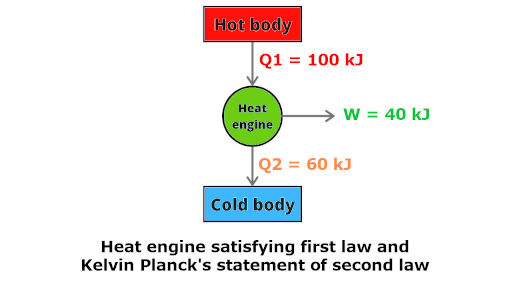
This type of heat engine (see above figure) is possible according to the statement/definition of second law of thermodynamics, because it is operating between two temperature reservoirs one at a higher temperature and other at a lower temperature.
And this engine will give efficiency less than 100%.
Thus, this heat engine obeys first law as well as second law of thermodynamics.
You can also remember this Kelvin Planck’s statement as shown below:
Look, we know that heat transfer takes place from higher temperature body to lower temperature body.
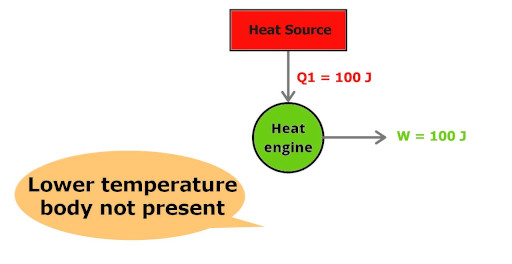
But here there is no lower temperature body. We have only one higher temperature body. So heat transfer cannot take place in this case.
And thus, this heat can not be converted to work without any heat transfer.
This is what Kelvin Planck’s statement wants to say.
It’s easy. Right? (Let me know in comments, if you have any queries)
How to remember Kelvin Planck’s statement?
Remember these two sentence:
“A heat engine must exchange the heat with at least two thermal reservoirs, one at higher temperature and other at lower temperature, then only the engine will operate.”
And
“Perfect engine with 100% efficiency is impossible”
Let’s move further, now let me explain you Clausius’s statement.
Second law of thermodynamics for heat pump/refrigerator (Clausius’s statement)
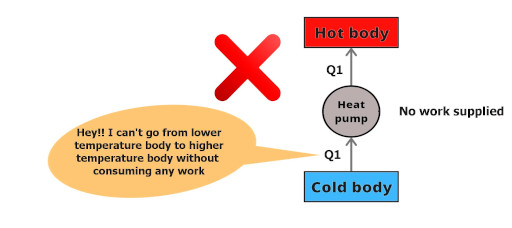
Here is a statement;
Clausius’s statement:
“It is impossible to construct a device (operating in a cycle) that can transfer heat from cold body to the hot body without absorbing any work.”
Or
“Heat can not itself flow from colder body to a hotter body.”
It’s very easy to understand, just see the above picture. Heat Q1 is at a lower temperature body and it is saying that it will not travel to a higher temperature body without absorbing any heat.
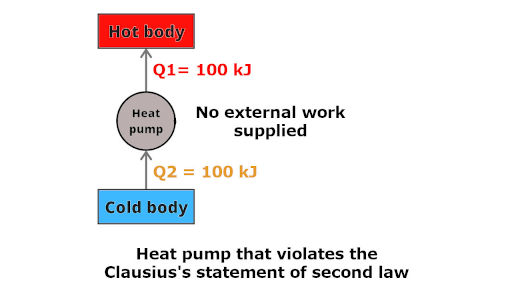
Consider a heat pump as shown in the above picture. This heat pump absorbs heat from the lower temperature body and rejects heat to the higher temperature body without supply of any work.
This phenomenon is possible according to 1st law of thermodynamics. But it does not obey the second law of thermodynamics.
Thus such a device can not transfer heat from lower temperature body to higher temperature body without any supply of work to it.
So according to Clausius’s statement of second law of thermodynamics, this type of heat pump is not possible.
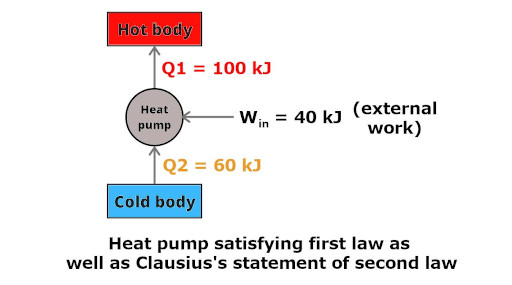
Now see this image. This type of heat pump is possible according to the statement/definition of second law of thermodynamics, because it is consuming some work in order to transfer heat from lower temperature body to higher temperature body.
Thus, this heat pump obeys 1st law as well as 2nd law of thermodynamics.
How to remember Clausius’s statement?
“Heat always flows from higher temperature body to lower temperature body. It’s reverse flow does not take place on its own.”
Well, I know it is little bit complicated to understand thermodynamics second law. But don’t worry guys. Just read this topic again, and you will get the clear idea (hahaha…)
Second law of thermodynamics based on entropy
Before starting the 2nd law of thermodynamics based on entropy, I would like to explain two terms;
- Randomness
- Entropy
1) Randomness:
The movement of molecules is known as randomness.

See this, how quiet the students are sitting on their bench and they are not moving at all. This is exactly the situation when there is a strict teacher in your class. Isn’t it?

I guess this is the exact situation which is seen during the recess time.
Students are moving here and there in a classroom.
Now you will come to know what randomness is. See in the first image, the students are not moving, that means they are just sitting in their position. Thus, their randomness is zero.
But in the second figure, the students are moving here and there during a recess time. This means that their randomness is more.
This is a simple concept of randomness.

Same thing happens in solids, liquids and gases too. Solids show less movement of molecules, liquids have more movement of molecules and gases show maximum movement of molecules as shown in the above image.
This movement of molecules is known as randomness.
Thus we can say that solids have less randomness, liquids have more randomness compared to solids and gases have maximum randomness.
Now let’s move to Entropy.
2) Entropy:
The measurement of randomness of the system is known as Entropy.
Or
Entropy is the measurement of disorder of the system.
It’s simple, it is just a measurement of how much randomly the molecules are moving in a system.
- In solids, the molecules are properly arranged, that means it has less randomness, so entropy of solids is least.
- In gases, the molecules move very fast throughout the container. It has more randomness which means it has more entropy.
- The entropy of liquids lies in between the solids and liquids
The formula for a change in entropy is given by;
∆S = ∆Q/T
Now, you will completely understand the second law of thermodynamics based on entropy.
Keep reading…
Entropy statement of Second law of thermodynamics
“In all the spontaneous processes, the entropy of the universe increases.”
Second law of thermodynamics equation (formula) can be stated as below;


Second law of thermodynamics equation is very important as it gives information about entropy. By knowing the entropy change, we can come to know whether the process will occur on it’s own or not.
Don’t worry. I know you didn’t understood anything in this statement. But I will give you amazing examples of second law of thermodynamics which will make you understand how entropy and second law of thermodynamics are related to each other.
You know what guys, whatever process occurs around us is based on the entropy principle.
Let’s take the example of our day to day life.

When we keep the cup of hot coffee on a table, what happens? The hot coffee will become cold after some time.
In thermodynamic terms, we can say that hot coffee loses heat to the surrounding.
Yes this is true. And everybody knows that. (You might be thinking that what’s the role of entropy in this phenomenon?)
Well, in this cooling of coffee, the entropy plays a very important role.
Let me show you this with a mathematical proof.
Assume that;
-The temperature of coffee is 50 °C. (i.e 323 K)
-The temperature of surrounding is 20 °C. (i.e 293 K)
Now, there are two possible case
- The coffee may absorb heat from the surrounding, or
- The coffee may release heat to the surrounding.
But, what will happen from these two cases? Let’s find it out through some calculations.
Case 1: Coffee is absorbing heat from the surrounding
Let say coffee (system) absorbs 10 joules of heat from the surrounding.
That means, the surrounding will lose 10 joules of heat.
So we can write,
Qsystem = +10 J
Qsurrounding = -10 J
Now, change in entropy of universe is given by equation;
∆Suniverse = ∆Ssystem + ∆Ssurrounding
= ∆Qsystem/Tsystem + ∆Qsurrounding/Tsurrounding
= (+10/ 323) + (-10/293)
= -0.00316 J/K
This is a negative value,
The entropy of the universe is decreasing here. Thus it violates the second law of thermodynamics (∆Suniverse should be greater than 0, but here our answer is negative).
So, we can say that this thermodynamic process is non spontaneous. This process of absorbing heat from the surrounding will not occur on its own.
Now, let’s take another case.
Case 2: Coffee is releasing heat to the surrounding
Let say coffee (system) releases 10 joules of heat to the surrounding.
That means, the surroundings will absorb 10 joules of heat.
So we can write,
Qsystem = -10 J
Qsurrounding = +10 J
Now, change in entropy of universe is given by equation;
∆Suniverse = ∆Ssystem + ∆Ssurrounding
= ∆Qsystem/Tsystem + ∆Qsurrounding/Tsurrounding
= (-10/ 323) + (+10/293)
= +0.00316 J/K
This is a positive value,
Kudos!! The entropy of the universe is increasing here. Thus it satisfies the entropy statement of second law of thermodynamics (∆Suniverse should be greater than 0).
So, we can say that this process is spontaneous. This process of releasing heat to the surrounding will occur on its own.
Well, in the above example you were already knowing that coffee is going to lose heat to the surrounding.
But in some other examples of chemical reactions, you may not be able to predict whether the chemical reaction will occur on its own or not.
So, calculating the entropy change for that particular reaction becomes important.
I hope you have clearly understood the Second law of thermodynamics in terms of entropy. Now let’s move further. Keep reading… The practical applications of this 2nd law of thermodynamics are on the way.
How Kelvin Planck’s and Clausius’s statement are related to each other?
I will explain to you the comparison of both these statements in a table form. So that it will be easy for you to understand.
| Kelvin Planck’s statement | Clausius’s statement |
| It is applied to heat engines | It is applied to heat pumps and refrigerators |
| It is a negative statement | It is also a negative statement |
| It is based on experimental observations and no mathematical proof | It is also based on experimental observations and no mathematical proof |
Second law of thermodynamics examples/applications in everyday life
Have you wondered what are the practical application of the second law of thermodynamics in our real life?
Let’s discuss this now.
Actually the second law of thermodynamics occurs all around us and you already have experienced all these things. I have mentioned a few examples of the second law of thermodynamics through which you will come to know about its real life applications.
1). Cars and bikes engine.
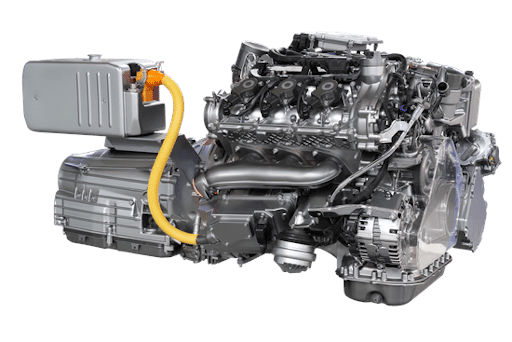
You know that heat flows from higher temperature body to lower temperature body and heat engine (car engine, bike engine, etc) working between these temperature reservoirs can produce work.
Don’t worry, there is animation of a heat engine later in this article. You will understand the heat engine in a better way.
2). Refrigerator using electricity to change the direction of heat flow.
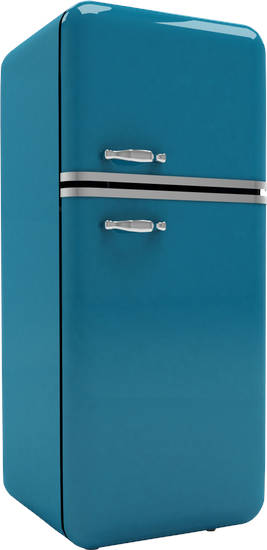
Clausius’s statement says that in order to make the flow of heat from lower temperature body to higher temperature body, there must be supply of work to the system. So a heat pump or refrigerator is an example which works on this principle.
In a heat pump and refrigerator, the electrical energy is given as Input work in order to make the flow of heat from lower temperature to higher temperature.
3). Hot coffee becomes cold on it’s own.

Now this example of 2nd law of thermodynamics is based on entropy statement. Hot coffee becomes cold on it’s own, because it’s temperature is higher than the surrounding temperature. So obviously heat will flow from higher temperature to lower temperature. In this way, heat of the coffee is rejected to the surrounding. The entropy of the universe increases by this process.
4). An object falls on the ground on it’s own.
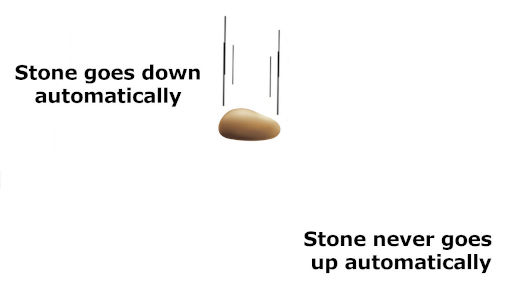
Have you ever seen any object going upward in the air on it’s own.
The answer is no.
According to the entropy statement of second law of thermodynamics, the process occurs in such a way that the entropy of the universe always increases. Thus the body falls down only and it never goes up on it’s own.
5). Ice kept on a table will melt on it’s own.
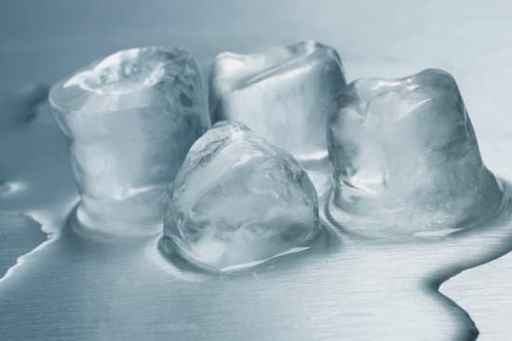
Once again remember the thumb rule: “Heat always flows from higher temperature body to a lower temperature body.”
Here the surrounding is a higher temperature body and ice is a lower temperature body. So heat will flow from the surrounding to ice. This ice will absorb heat from the surrounding and it will melt. This process occurs on it’s own and the entropy of the universe increases.
6). Air leaks from the balloon.
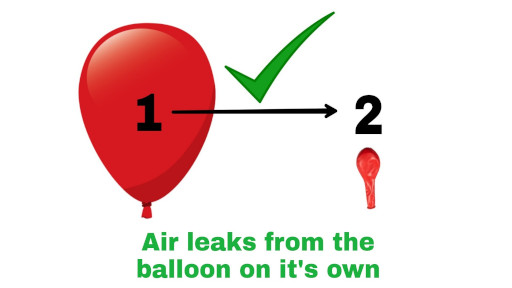
Air always comes out of the balloon on it’s own. It never goes inside the balloon in it’s own. This phenomenon is based on the entropy statement of 2nd law of thermodynamics.
7). Gases will mix automatically on it’s own.

We have already discussed this example in the previous section. Here two gases are separated with the white separator. If we will remove this separator, then they will automatically get mixed with each other such that the entropy increases.
8). Water always flows from higher level to lower level.
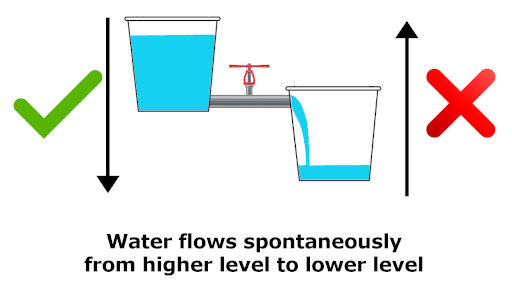
Water never goes up on it’s own. But it always flows from a higher level to lower level spontaneously (on its own).
9). A gas takes the entire volume of a container.
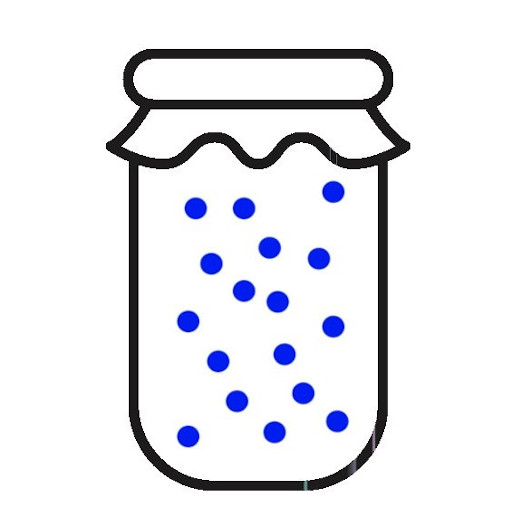
If we add a small amount of gas in a room or a container, then it will occupy the entire volume of the room or container. This process occurs on it’s own. And yes this is based on the 2nd law of thermodynamics.
Heat engine
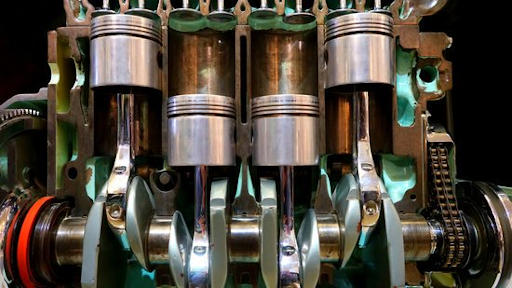
You might have seen such engines.
Just ask yourself, how does this engine work?
.
.
.
.
.
.
Yes, it works with the help of fuel. The fuel burns inside the engine and produces heat. This heat is used to do some useful work.
Let me explain to you with a simple diagram.

As shown in above figure, there are two bodies, hot body and a cold body.
Now, in the above discussion on heat transfer, I mentioned that heat transfer always takes place from hot body to cold body.
So here also heat will flow from hot body to cold body.
Let,
Q1 = Heat transferred from the hot body
Q2 = Heat received by the cold body.
Now, if we keep the engine between this hot body and cold body, then work can be produced from this engine as heat flows from the hot body to the cold body.
Now, I’ll give you the short and simple definition of heat engine.
Keep reading.
Heat engine: Heat engine is a device which is used for producing the motive power from the heat.
Or
Heat engine is a machine or a device which converts heat energy into mechanical energy (work) by transfer of heat from high temperature to lower temperature.
Hey,
Do you know, in the above picture how much of work can be produced by transfer of heat Q1 and Q2 as shown in picture.
Here, the total amount of work done by this heat engine will be;
W = Q1 – Q2
The unit of work done is the same as the unit of heat, i.e Joule (J).
Thermal efficiency of heat engine
The thermal efficiency of heat engine is the ratio of net output work (W) to the heat supplied (Q1) to the engine.
Thermal efficiency = (net output work) / (heat supplied)
The thermal efficiency of a heat engine is given by the following equation.
η = W/Q1
Are you enjoying thermodynamics?
Let me know in the comments section (I would be happy to know this)
Heat pump
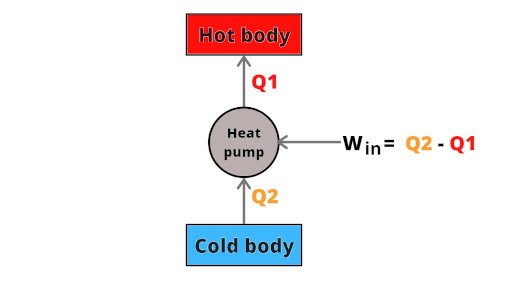
Now look, in the heat engine we saw that heat transfer takes place from higher temperature body to the lower temperature body and the device or machine produces some useful work. And that’s obviously right.
But what if we want to transfer the heat in the reverse direction? i.e from lower temperature body to higher temperature body.
Heat transfer never takes place from lower temperature to higher temperature on it’s own.
In this case a new device is used to do so, and this device is known as a heat pump.
As shown in above diagram, heat pump extracts Q1 amount of heat from the lower temperature body and delivers Q2 amount of heat to the higher temperature body.
But will this heat transfer take place on it’s own?
No.
We need to supply some work to this device in order to transfer the heat from lower temperature to higher temperature.
Let me give you a simple definition.
Heat pump: Heat pump is a device which is used to transfer heat from lower temperature to higher temperature by using some input work.
Do you know what amount of mechanical energy is supplied in this heat pump for transfer of heat from lower temperature body to higher temperature body?
The amount of input work required is;
W = Q2 – Q1
The unit of this work done is Joule (J)
Coefficient of performance of heat pumps/refrigerators
In heat pumps and refrigerators, the term efficiency is replaced by Coefficient of performance (COP).
COP is defined as a ratio of heat absorbed (Q2) to the work input (W) to the system.
COP = (heat absorbed) / (work input to the system)
= Q2/W
Second law of thermodynamics example (it’s easy)
Now I will show you some numericals based on the second law of thermodynamics.
Example 1: (based on Kelvin Planck’s statement)
A heat engine absorbs 360 J of energy and performs 25 J of work in each cycle. Find the following;
(a) the efficiency of the engine
(b) the energy expelled to the cold reservoir in each cycle.
Solution:
Here,
Q1 = 360 J,
W = 25 J
(a) Efficiency of heat engine
η = W/Q1
= 25 / 360
= 0.07 or 7%
(b) The heat energy expelled to the cold reservoir in each cycle
Q2 = Q1 – W
= 360 – 25
= 335 J
Example 2: (based on Clausius’s statement)
A refrigerator has a coefficient of performance equal to 5. Assuming that the refrigerator absorbs 120 J of energy from a cold reservoir in each cycle, find
(a) The work required in each cycle.
(b) The energy expelled to the hot reservoir.
Solution:
Here,
COP = 5,
Q2 = 120 J
(a) COP = Q2/W
Hence, W = Q2/COP
= 120 / 5
= 24 J
(b) The energy expelled to the hot reservoir
Q1 = W + Q2
= 24 + 120
= 144 J
Example 3: (based on Entropy)
“Will ice having temperature 273 K placed in a surrounding having temperature 298 K will give water having temperature 273 K ?” Prove this statement. The ice requires 6.025 kjoule/mole of heat energy for melting.
Solution:
1 mole of ice will have to absorb 6.025 kilojoule/mole heat from the atmosphere to change into water at 273 K temperature. Hence, the change in entropy of the system and the surrounding can be calculated as shown below.
∆Ssystem = ∆Q/T
= 6.025/273
= 0.0221 kilojoule/mole
Surrounding will lose 6.025 kjoule heat but decrease of 6.025 kjoule heat from very large surrounding will not make any real change in the temperature of the surrounding and so it can be neglected.
∆Ssurrounding = ∆Q/T
= -6.025/298
= -0.0202 kilojoule/K mole
(Heat is absorbed here, so the sign of ∆Q is negative)
Now,
∆Suniverse = ∆Ssystem + ∆Ssurrounding
= 0.0221 + (-0.0202)
= 0.0019 kilojoule/K mole
Here, ∆Suniverse >0, so this process will occur on it’s own. As a value of ∆Suniverse >0 is positive (+ve), it can be the same that if an ice cube is kept in a surrounding having temperature 298 K, it will melt on it’s own and it will give water at 273 K temperature.
But opposite to this, the water kept at temperature 298 K, will not be converted into ice on it’s own.
You can try to check this out by calculations if you want.
Carnot cycle and Carnot engine
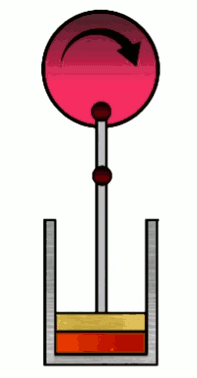
All of you might have seen the engine of cars, bikes or any vehicle.
But what is the process going on in the engine?
In 1824, this actual working process of engines was explained by engineer Sadi Carnot. This process is known as Carnot cycle.
Sadi Carnot explained about what parts of the engine?
He also explained what should be the ideal engine, and what should be the various processes through which an engine should go through, in order to produce work from it.
Sadi Carnot gave the theoretical explanation of this engine, meaning he explained different parts of engines and he explained about the working of this engine.
During this theory on carnot engine he made few assumptions, so this engine is an ideal engine (hypothetical engine)
Sadi Carnot designed this engine which is having efficiency of 100%.
(Note: Carnot engine is just an ideal engine (or hypothetical engine). No engine has 100% efficiency according to second law of thermodynamics)
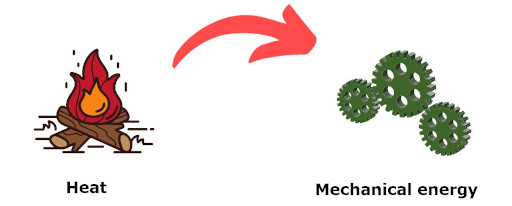
Heat engine is nothing but a device which converts heat energy into useful mechanical work. (For example, engine of cars, bike, steam engine, etc are heat engine)
Carnot suggested that, if a heat engine is passed through some thermodynamic stages, then it may be possible to get 100% efficiency of the heat engine.
This engine is called the Carnot engine or ideal heat engine.
He suggested the working process for this Carnot engine and this cyclic process is known as Carnot cycle.
Carnot heat engine consist of following 4 parts:
1). Insulated non conducting stand
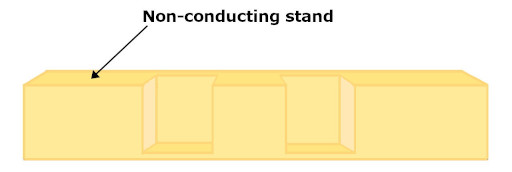
This is an insulated (non-conducting) stand which does not allow heat transfer through it.
2). Hot reservoir
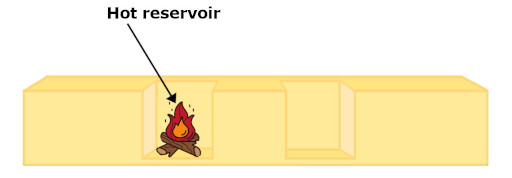
The hot reservoir is such that its temperature remains constant throughout the process. It is also known as a heat source.
3). Cold reservoir

The cold reservoir is such that its temperature remains constant throughout the process. It’s temperature should not change even if any amount of heat is added to it. It is also known as heat sink.
4). Cylinder with a working fluid
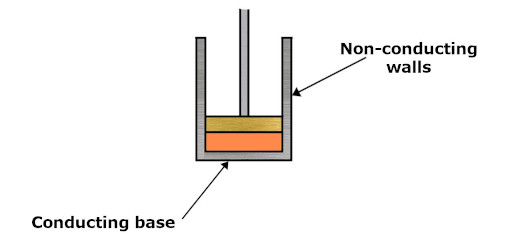
The cylinder walls are insulated so that heat will not transfer through the walls. The walls of cylinder are made up of non conducting material.
The base of the cylinder is conducting and heat transfer takes place through it. The cylinder is fitted with a movable piston as shown in figure. The working fluid inside the cylinder can be liquid or gas.
All the process occurring in the Carnot engine is represented graphically on a P-V diagram. But for that let us understand the Carnot cycle.
There are four process involved in the Carnot cycle
- Isothermal expansion
- Adiabatic expansion
- Isothermal compression
- Adiabatic compression
Let me explain all these processes very quickly and trust me it’s very easy.
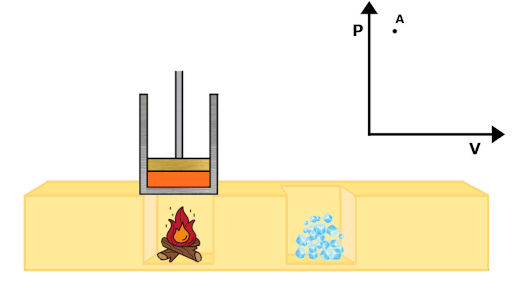
First of all place the cylinder on the hot reservoir. The temperature of the hot reservoir is higher than the temperature of the working fluid (gas), the heat flows from the hot reservoir to the gas.
1). Isothermal expansion
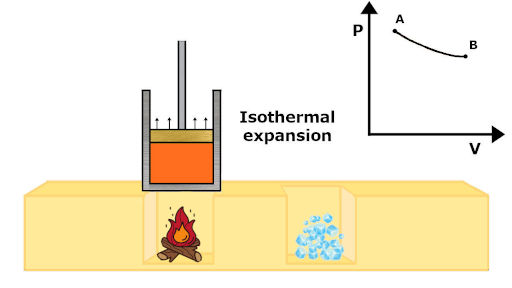
Due to this process, the gas starts to expand and the piston rises upward as shown in image. As the gas expands during this process, it’s temperature remains constant. Due to this constant temperature expansion, this process is known as isothermal expansion.
During the upward movement of the piston, the volume of the gas increases and its pressure decreases, which is shown in the PV diagram (A to B).
2). Adiabatic expansion
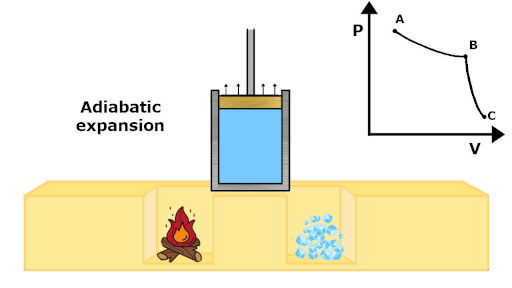
Now, the cylinder is placed on an insulating stand. Now due to insulated walls from all the sides, the gas does not exchange it’s heat (no heat transfer takes place over here). So the process is an adiabatic process.
But the piston keeps on rising upward due to the inertia of the wheel. Thus it’s an expansion process, and this process takes place without any heat transfer (because the bottom is insulated in this stage). Thus, this process is known as adiabatic expansion.
Since the gas is expanding without gaining any heat, it’s temperature decreases and pressure also decreases. This process is shown in PV diagram (B to C)
3). Isothermal compression
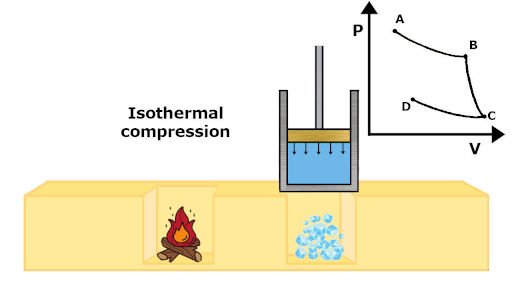
Now place the cylinder on a cold reservoir. Due to the inertia effect of the wheel, the piston moves downward and the compression of the gas takes place.
The cold reservoir absorbs all the heat from the gas and this compression takes place at constant temperature. So this process is known as isothermal compression.
Due to this compression process, the volume of the gas decreases and the pressure increases which is shown in the PV diagram as C to D.
4). Adiabatic compression
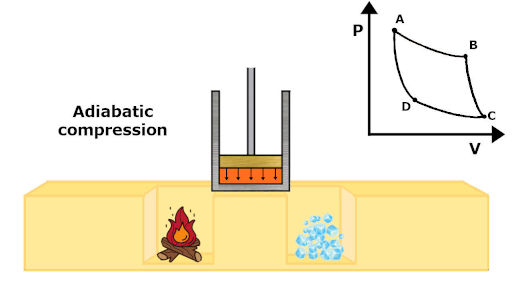
In this last step, bring the cylinder on the insulated stand.
The piston continues to move downward due to the inertia effect of the wheel.
But now, there is no cold reservoir to absorb the heat from the cylinder. Because of this, the temperature of the gas starts increasing. This compression process occurs without any heat transfer, so it is known as adiabatic compression. Here, the gas is compressed such that its temperature rises back to that of the hot reservoir.
During this process the volume of the gas decreases and pressure increases. This is shown in the PV diagram as D to A.
After this step, the gas returns to its initial stage and this complete cycle is known as Carnot cycle.
The energy working on this cycle is called the Carnot engine.
Perpetual motion machine of second kind PMM-2
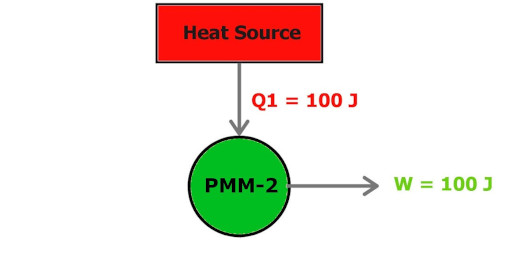
Any device or a machine which does not obey the second law of thermodynamics is known as a perpetual motion machine of second kind PMM-2.
See the above engine. It absorbs heat from the single heat source and converts all these energy into work.
According to Kelvin Planck’s statement for second law, it is impossible to construct such a device working on a single heat source and having 100% efficiency.
Thus, this device violates the second law of thermodynamics. Hence it is known as a Perpetual motion machine of second kind PMM-2.
Summary (Read this if you are in hurry)
Most important question. Why do we use the 2nd law of thermodynamics?
- Second law of thermodynamics is used to check whether the process is spontaneous or not. (Whether the process occurs on its own or not?)
- It also tells us the direction in which the process will proceed.
What is Second law of thermodynamics definition/statement?
The statements/definition of second law of thermodynamics are discussed below;
Kelvin Planck’s statement:
“It is impossible to construct a device (operating in a cycle) which works on a single heat source and converts all of its heat completely in to work”
Clausius’s statement:
“It is impossible to construct a device (operating in a cycle) that can transfer heat from cold body to the hot body without absorbing any work.”
Or
“Heat can not itself flow from colder body to a hotter body.”
Entropy statement of Second law of thermodynamics:
“In all the spontaneous processes, the entropy of the universe increases.”
Second law of thermodynamics practical examples/applications in our everyday life.
Real life examples of second law of thermodynamics are mentioned below.
1). Cars and bikes engine.
2). Refrigerator using electricity to change the direction of heat flow.
3). Hot coffee becomes cold on it’s own.
4). An object falls on the ground on it’s own.
5). Ice kept on a table will melt on it’s own.
6). Air leaks from the balloon.
7). Gases will mix automatically on it’s own.
8). Water always flows from higher level to lower level.
9). A gas takes the entire volume of a container.
Carnot cycle and Carnot engine
In 1824, this actual working process of engines was explained by engineer Sadi Carnot. This process is known as Carnot cycle. The energy working on this Carnot cycle is called Carnot engine.
There are four process involved in the Carnot cycle
- Isothermal expansion
- Adiabatic expansion
- Isothermal compression
- Adiabatic compression
(Note: Carnot engine is just an ideal engine (or hypothetical engine). No engine has 100% efficiency according to second law of thermodynamics)
Perpetual motion machine of second kind PMM-2
Any device or a machine which does not obeys the second law of thermodynamics is known as a perpetual motion machine of second kind PMM-2.
Important Guides for you
Also read:
- What is Thermodynamics? (35+ topics with Definitions and examples)
- Zeroth law of thermodynamics
- What is First law of thermodynamics?
- First law of thermodynamics definition/statement (In simple way)
- Examples of First Law of Thermodynamics / Law of conservation of Energy
- First law of thermodynamics equation (A practical explanation)
- Limitations of First Law of Thermodynamics
- What is Third law of thermodynamics? (in simple terms)
- Laws of thermodynamics
- What is Carnot Cycle in Thermodynamics?
- What is the definition of entropy in thermodynamics?
- Heat capacity vs specific heat in thermodynamics
- What is Thermodynamic Equilibrium? (With Best Example)
- Thermodynamic Process (With Examples)
- What is Thermodynamic System? – Open, Closed & Isolated system (With Examples)
